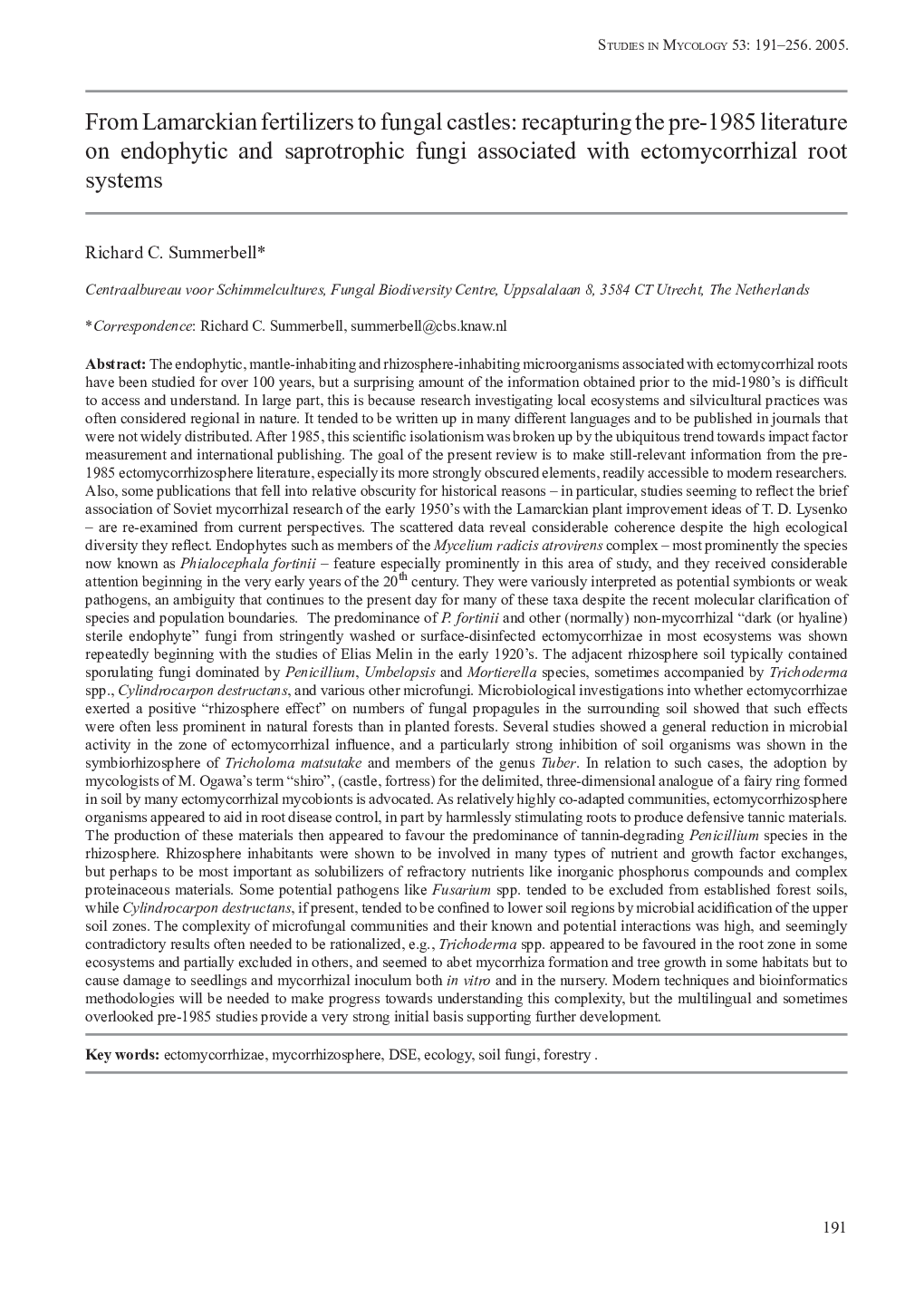| کد مقاله | کد نشریه | سال انتشار | مقاله انگلیسی | نسخه تمام متن |
|---|---|---|---|---|
| 9442574 | 1616967 | 2005 | 66 صفحه PDF | دانلود رایگان |
عنوان انگلیسی مقاله ISI
From Lamarckian fertilizers to fungal castles: recapturing the pre-1985 literature on endophytic and saprotrophic fungi associated with ectomycorrhizal root systems
دانلود مقاله + سفارش ترجمه
دانلود مقاله ISI انگلیسی
رایگان برای ایرانیان
کلمات کلیدی
موضوعات مرتبط
علوم زیستی و بیوفناوری
علوم کشاورزی و بیولوژیک
بوم شناسی، تکامل، رفتار و سامانه شناسی
پیش نمایش صفحه اول مقاله

چکیده انگلیسی
The endophytic, mantle-inhabiting and rhizosphere-inhabiting microorganisms associated with ectomycorrhizal roots have been studied for over 100 years, but a surprising amount of the information obtained prior to the mid-1980's is difficult to access and understand. In large part, this is because research investigating local ecosystems and silvicultural practices was often considered regional in nature. It tended to be written up in many different languages and to be published in journals that were not widely distributed. After 1985, this scientific isolationism was broken up by the ubiquitous trend towards impact factor measurement and international publishing. The goal of the present review is to make still-relevant information from the pre-1985 ectomycorrhizosphere literature, especially its more strongly obscured elements, readily accessible to modern researchers. Also, some publications that fell into relative obscurity for historical reasons - in particular, studies seeming to reflect the brief association of Soviet mycorrhizal research of the early 1950's with the Lamarckian plant improvement ideas of T. D. Lysenko - are re-examined from current perspectives. The scattered data reveal considerable coherence despite the high ecological diversity they reflect. Endophytes such as members of the Mycelium radicis atrovirens complex - most prominently the species now known as Phialocephala fortinii - feature especially prominently in this area of study, and they received considerable attention beginning in the very early years of the 20th century. They were variously interpreted as potential symbionts or weak pathogens, an ambiguity that continues to the present day for many of these taxa despite the recent molecular clarification of species and population boundaries. The predominance of P. fortinii and other (normally) non-mycorrhizal “dark (or hyaline) sterile endophyte” fungi from stringently washed or surface-disinfected ectomycorrhizae in most ecosystems was shown repeatedly beginning with the studies of Elias Melin in the early 1920's. The adjacent rhizosphere soil typically contained sporulating fungi dominated by Penicillium, Umbelopsis and Mortierella species, sometimes accompanied by Trichoderma spp., Cylindrocarpon destructans, and various other microfungi. Microbiological investigations into whether ectomycorrhizae exerted a positive “rhizosphere effect” on numbers of fungal propagules in the surrounding soil showed that such effects were often less prominent in natural forests than in planted forests. Several studies showed a general reduction in microbial activity in the zone of ectomycorrhizal influence, and a particularly strong inhibition of soil organisms was shown in the symbiorhizosphere of Tricholoma matsutake and members of the genus Tuber. In relation to such cases, the adoption by mycologists of M. Ogawa's term “shiro”, (castle, fortress) for the delimited, three-dimensional analogue of a fairy ring formed in soil by many ectomycorrhizal mycobionts is advocated. As relatively highly co-adapted communities, ectomycorrhizosphere organisms appeared to aid in root disease control, in part by harmlessly stimulating roots to produce defensive tannic materials. The production of these materials then appeared to favour the predominance of tannin-degrading Penicillium species in the rhizosphere. Rhizosphere inhabitants were shown to be involved in many types of nutrient and growth factor exchanges, but perhaps to be most important as solubilizers of refractory nutrients like inorganic phosphorus compounds and complex proteinaceous materials. Some potential pathogens like Fusarium spp. tended to be excluded from established forest soils, while Cylindrocarpon destructans, if present, tended to be confined to lower soil regions by microbial acidification of the upper soil zones. The complexity of microfungal communities and their known and potential interactions was high, and seemingly contradictory results often needed to be rationalized, e.g., Trichoderma spp. appeared to be favoured in the root zone in some ecosystems and partially excluded in others, and seemed to abet mycorrhiza formation and tree growth in some habitats but to cause damage to seedlings and mycorrhizal inoculum both in vitro and in the nursery. Modern techniques and bioinformatics methodologies will be needed to make progress towards understanding this complexity, but the multilingual and sometimes overlooked pre-1985 studies provide a very strong initial basis supporting further development.
ناشر
Database: Elsevier - ScienceDirect (ساینس دایرکت)
Journal: Studies in Mycology - Volume 53, 2005, Pages 191-256
Journal: Studies in Mycology - Volume 53, 2005, Pages 191-256
نویسندگان
Richard C. Summerbell,